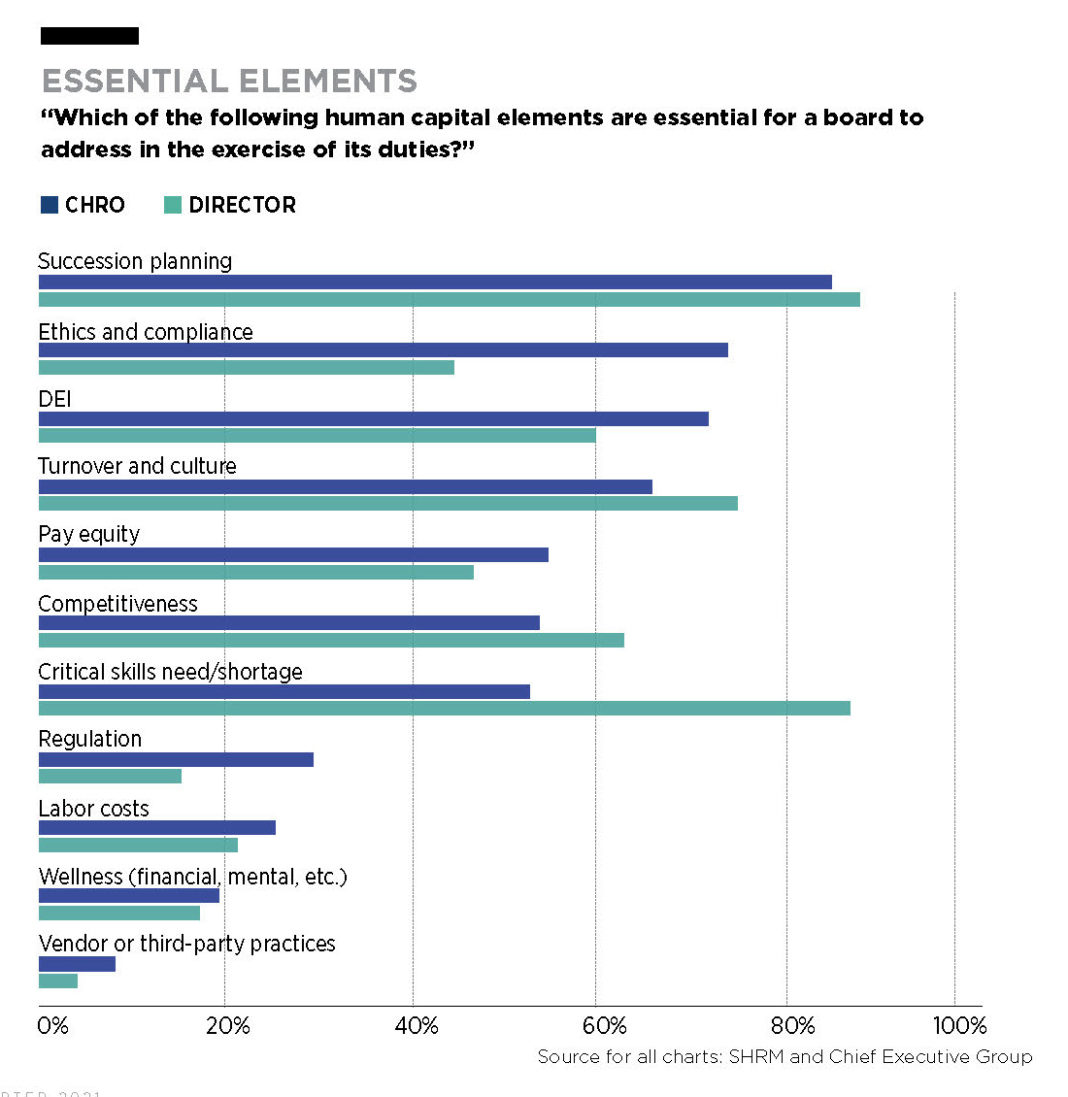With the talent war intensifying and companies looking for ways to cope with what’s come to be known as the “Great Resignation,” boards are understandably preoccupied with the risks related to talent and skills shortages. A new SEC rule requiring companies to expand their human capital management disclosures in their 10-Ks has only added to the focus. Increasingly, directors are changing charters to add human capital oversight to their comp committees and are looking for a lot more data about talent from management.
Yet, when it comes to many of the most essential people issues facing companies right now, new research from Corporate Board Member, done in partnership with the Society for Human Resource Management (SHRM), finds a potentially worrisome gap between the expectations of directors and CHROs.

Our survey found 86 percent of directors, for example, rating information around the company’s “critical skills need/ shortage” as a must-have, while only 52 percent of CHROs said the same. Meanwhile, almost three-quarters of CHROs prioritized “ethics and compliance” as a top board concern compared with just 44 percent of directors, and CHROs chose “regulation” as an essential human capital element twice as often as directors. As you’d expect, the two groups agreed on succession planning as a top priority.
“There may be a disconnect between boards recognizing culture and human capital management as part of their purview” and HR viewing the board as having a consulting role rather than having direct oversight, says Maryann Bruce, board member at Amalgamated Bank. “You want management and the board to be on the same page. If we’re not, board members won’t feel like they’re getting what they need, and HR is going to feel like you’re in the weeds, you’re micromanaging. So you’ll have misunderstandings.”
Susan Skerritt, who sits on several boards, including Tanger Outlets, VEREIT, Community Bank System and Falcon Group, agrees. While the CHRO might view talent strategy as primarily the responsibility of management, “from the board’s perspective, the board has a fundamental responsibility to identify and mitigate risk, and people—and the behaviors and actions of people—can be a very significant risk.”
The Board’s Role in Talent
This shift to categorizing “people issues” as a business risk—and thus a board concern— rather than just part of routine business operations began even before the pandemic. This last year only accelerated the reclassification among directors. That may explain why many directors we polled felt they weren’t getting the key HR data they want. For example, while 100 percent of the directors we surveyed reported sufficient input on CEO and senior executive compensation and 88 percent were satisfied with information related to succession planning, only 64 percent felt they had adequate information on the company’s talent strategy metrics, and just 62 percent were getting enough data on workforce pay equity.

“Talent shortages were a huge issue before the pandemic, and they’re a bigger issue now and much more widespread,” says Laurie Siegel, director with Lumen and FactSet, who notes that when the board and management devise a strategic direction for the company, the board’s role “is to de-risk our ability to execute against that.” Right now, she adds, that absolutely means dealing with the skills shortage.
But, says Mike Paolucci, a CHRO at Arena Pharmaceuticals and a board member at Orthofix, part of the problem is that boards don’t always know what they need. “The amount of information about people that we have at our fingertips as CHROs is enormous. So you have to be able to ask for the data the right way.”
Alexander Alonso, the chief knowledge officer at SHRM, says there’s an opportunity here—the data disconnect can be a great place to start improving communication between HR and the board. “It’s critical for CHROs to have conversations with their boards to understand the data needs of the directors. It’s possible that CHROs are providing this information indirectly to the board, but it’s getting lost in the vast amounts of information that boards have to review. Having conversations about which data points to include and how to present them may create an environment where CHROs and directors agree on what metrics are being reported.”

This might help bridge the divide on the subject of the board’s role on talent strategy—including employee wellness and workplace culture. Among CHROs we polled, 41 percent—the largest segment in the results—felt boards should be briefed on, but not required to oversee, talent strategy. Only 16 percent of directors agreed. “People are the most valuable asset, which makes it one of the biggest risks,” says Gary LeDonne, board member at MVB Financial, but he notes that CHROs might be thinking of talent decisions much further down in the organization, which the board would likely not spend much time on in meetings.
In general, CHROs say they have spent more time over the past year discussing talent strategy (85 percent) than in previous years, compared with just over two-thirds of directors, and 31 percent of board members reported no change in time spent.

Workplace culture followed a similar trend, with 31 percent of boards expressing a desire to be deeply involved in oversight of culture but just 13 percent of CHROs feeling the same way; most of the latter group identified it as a topic boards should be briefed on but not deeply involved in overseeing—”unless there’s a problem,” says Stephanie Phipps, CHRO for Mustang Fuel. If, for example, an employee survey showed the company was moving in the wrong direction on a cultural issue, “I need to report that to the board, along with a set of action items that I would have developed with the executive team to say, ‘Here’s what we want to do to turn this around.’ The board could approve that or they could make different recommendations, but I wouldn’t see them building a culture strategy.”
Only one in 10 CHROs thought employee wellness should be included in the board’s overarching risk discussion, compared with more than one-quarter of directors—and 58 percent of CHROs said oversight was not necessary on this issue. Before the pandemic, Siegel says she would have agreed. “But since Covid, there has been a massive increase in mental health issues for both employees and their families.” It’s a risk issue, she adds. “Is your workforce capable of functioning as fully as they may have been a year and a half ago?”
Overly Optimistic Directors?
Perhaps the most profound gap between the perceptions of directors and CHROs from the research—and one worth particular focus among board members—was the way each group assessed the leadership ability of management.
Among our respondents, just 19 percent of CHROs called their companies’ executive teams “a leader” among peer companies, compared with 41 percent of directors. Phipps says that isn’t so surprising. “One of the things that anybody in HR has the ability to see is—everything,” she says. “We are generally the first stop on where the things that aren’t healthy in an organization get discussed, which is important, but it can have the ability to jade our perspective. If you’re a CHRO and your peers are on the executive team, you see the imperfections with some of the decisions they make” much more often than the board will.

Case in point: diversity, equity and inclusion. Among directors, 76 percent expressed high confidence in management’s DE&I efforts—compared with just 51 percent of CHROs. “HR executives [may be thinking], ‘We’ve been talking about this for a long time, but we don’t see enough change,’” says Bruce. Meanwhile, she says she has attended board meetings where directors expressed frustration with the amount of time spent on DE&I. “[They’ll say], ‘I’m so sick and tired of hearing about diversity and inclusion, it’s all we ever talk about.’ So I think CHROs are more in reality and boards are more aspirational or optimistic.”
Perhaps tellingly, the two groups even diverged on who was ultimately responsible for ensuring DE&I across the company: 82 percent of directors said the buck stops with the CEO, compared with only 62 percent of CHROs who pointed to the corner office; by contrast, 84 percent of CHROs named themselves as responsible, compared with just 69 percent of boards holding them similarly accountable. “I don’t think there’s any question that the CEO sets the culture and the tone,” says Arthur Bacci, who sits on the board of GreenSky. “The executive team will follow the CEO’s lead. If David [Zalik, CEO of GreenSky] doesn’t make it a priority, I don’t think the executive team would either.”

Mike Nevens, chairman of the board at NetApp and director with TalonX and Ciena, agrees that the responsibility is “unequivocally” with the CEO. “They have to lead by example, they have to insist it’s a priority. They have to say, ‘We’re going to make progress on this, no excuses accepted.’”
Interestingly, 47 percent of directors held themselves responsible, compared with just 20 percent of CHROs saying the same. “The board is too far removed from individuals in the organization who are perpetuating or changing day-to-day life,” says Phipps. “I love the idea of willingness to take responsibility for it, but I don’t think that’s practical.”
In general, Paolucci says the differences in survey responses reflect a larger disparity on “where board oversight starts and stops. A lot of board members used to run big companies, and they’re used to making these decisions.”
The issue of “nose in, fingers out” is hardly a new one, but arguably, the topic of human capital has only recently moved to center stage in boardroom discussion, and metrics such as pay equity are new additions to the agenda. Both boards and management are still figuring out what governance requires—and what it will require in the future. “It’s like any new topic,” says Nevens. “We’re kind of feeling our way.”








